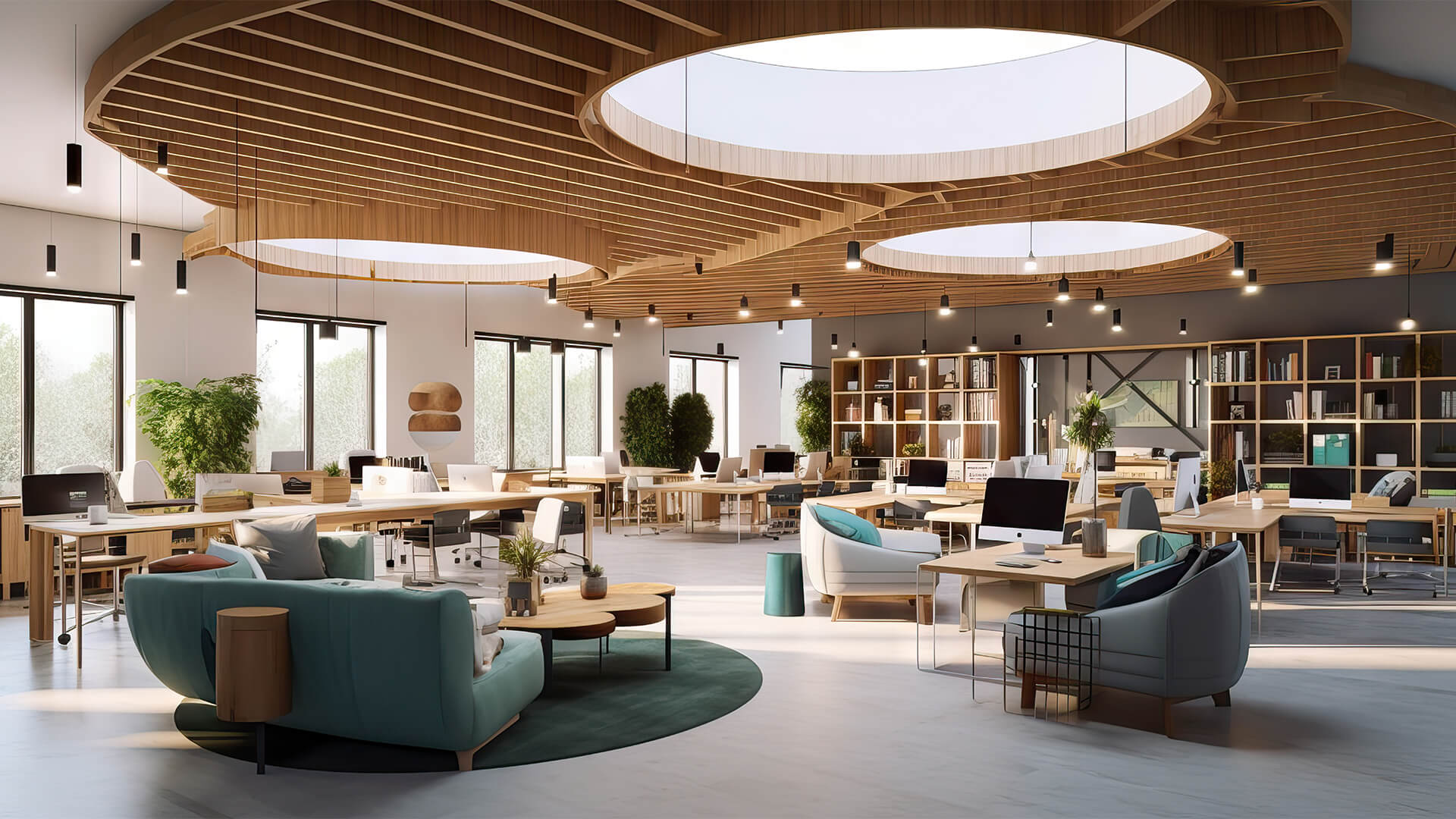In recent years, the concept of coworking spaces has gained immense popularity as a flexible and collaborative alternative to traditional office environments. As more entrepreneurs, freelancers, and remote workers seek out these shared workspaces, construction planners must incorporate key features that enhance productivity, foster a sense of community, and provide a comfortable and functional work environment. This article explores essential features to include in your coworking space construction plan.
Flexible Layout Design: Promoting Collaboration and Productivity
A coworking space should be designed with versatility in mind. A flexible layout allows for the accommodation of different work styles and preferences, ultimately fostering collaboration and productivity. Start by creating a variety of workspaces, such as open desks, private offices, meeting rooms, and dedicated lounges. This allows individuals to choose the environment that suits their specific needs. Incorporate movable partitions or sliding doors to provide the option of privacy when required, while maintaining an open and connected atmosphere.
Think about the inclusion of modular furniture and flexible workstations. These elements can be easily reconfigured to accommodate various group sizes or individual preferences. Ergonomic chairs and adjustable desks are also essential to ensure the comfort and well-being of coworkers, promoting better focus and productivity throughout the day. By prioritizing flexibility in the layout design, you create an inclusive and adaptable workspace that caters to the diverse needs of your coworking community.
State-of-the-Art Technology Infrastructure: Empowering Connectivity and Efficiency
To support the needs of modern professionals, a robust and reliable technology infrastructure is paramount. High-speed internet connectivity is a non-negotiable feature, as it is the backbone of any coworking space. Opt for fiber-optic connections and invest in network equipment capable of handling heavy usage demands. To further empower connectivity, provide ample power outlets and charging stations throughout the space, ensuring that members can easily plug in their devices and stay productive.
Moreover, incorporate smart technology solutions, such as smart locks for secure access, smart thermostats for efficient temperature control, and automated lighting systems to optimize energy consumption. These features not only enhance the overall user experience but also contribute to cost savings and environmental sustainability. Consider offering technology-enabled amenities, such as video conferencing equipment, large screens for presentations, and high-quality sound systems, to facilitate seamless collaboration and enhance the value proposition of your coworking space.
Inviting Common Areas: Building a Sense of Community and Well-being
Beyond providing functional workspaces, coworking environments should prioritize the creation of inviting and comfortable common areas. Spaces such as Workit Spaces serve as hubs for networking, relaxation, and community-building. Include well-designed communal kitchens or café areas, where coworkers can socialize, enjoy a cup of coffee, or have a casual meeting. Integrate natural elements, such as plants and natural light, to create a refreshing and inspiring atmosphere.
Incorporate breakout zones with cozy seating arrangements, encouraging impromptu discussions and idea sharing. Including recreational amenities like pool tables, foosball tables, or even yoga studios can offer a much-needed break from work and promote physical and mental well-being. Thoughtful design elements, such as art installations, motivational quotes, and comfortable lounge furniture, contribute to a welcoming and vibrant environment that fosters creativity, collaboration, and a sense of belonging.
Creating a Safe and Secure Environment: Prioritizing Safety Measures
When designing a coworking space, ensuring the safety and security of the occupants should be a top priority. Implementing robust safety measures not only protects the members but also instills confidence and trust in the space. Start by installing a comprehensive security system, including surveillance cameras, access control systems, and alarms. This deters unauthorized access and provides a sense of safety within the premises.
Consider incorporating designated emergency exits and clear signage throughout the space to ensure easy navigation during critical situations. Adequate fire safety measures, such as fire extinguishers, smoke detectors, and sprinkler systems, should also be included. Collaborate with professional architects and contractors to ensure compliance with local safety regulations and best practices.
Promoting Wellness and Work-Life Balance: Wellness Facilities and Amenities
Recognizing the importance of holistic well-being in a coworking environment can significantly enhance the overall experience for members. Include wellness facilities and amenities to support physical and mental health. Incorporate dedicated spaces for fitness activities, such as a gym or exercise studio, to encourage members to prioritize their health. Alternatively, offer wellness programs and organize workshops, such as yoga or meditation sessions, to promote relaxation and stress reduction.
To cater to members’ needs for work-life balance, provide amenities such as nap rooms or quiet zones where individuals can take breaks or rejuvenate. Incorporating wellness-focused design elements, such as natural lighting, comfortable seating, and biophilic elements, can contribute to a calming and rejuvenating atmosphere. By prioritizing wellness, your coworking space becomes a place where members can thrive both personally and professionally.
Thoughtful Amenities and Services: Enhancing Convenience and Productivity
In addition to the essential features mentioned above, including thoughtful amenities and services can further enhance the convenience and productivity of your coworking space. Offer amenities such as high-quality printing and scanning facilities, mail and package handling services, and on-site IT support. These services alleviate administrative burdens and enable members to focus on their work without disruptions.
Consider incorporating a dedicated café or food service area, providing members with easy access to refreshments and nourishing meals. Collaborate with local vendors or partner with food delivery services to offer a diverse range of culinary options. Provide ample storage spaces, lockers, or personal storage units to accommodate the belongings of members who require long-term or daily storage solutions.
By offering these thoughtful amenities and services, your coworking space becomes a one-stop destination that caters to the practical needs of professionals, allowing them to maximize their productivity and focus on their core activities.
Embracing Sustainability: Incorporating Green Design and Practices
Incorporating sustainability into the construction plan of a coworking space is not only responsible but also highly appealing to environmentally conscious professionals. Consider integrating green design principles and practices throughout the space. Use energy-efficient lighting fixtures, such as LED bulbs, and install motion sensors to ensure lights are only active when needed. Incorporate natural ventilation systems and prioritize the use of eco-friendly materials, such as recycled or low VOC (volatile organic compound) products, for construction and furnishing.
Implement recycling and waste management systems to encourage members to reduce their environmental impact. Provide easily accessible recycling bins and educate members on proper waste disposal practices. Consider incorporating sustainable transportation options, such as bike racks or electric vehicle charging stations, to promote eco-friendly commuting.
Building a Vibrant Community: Engaging Events and Networking Opportunities
As already said, coworking space is not just a place to work; it is also a platform for networking, collaboration, and personal growth. To foster a vibrant community, include spaces specifically designed for events and networking opportunities. Create a dedicated event space or multi-purpose room that can accommodate workshops, seminars, and networking events. This allows members to connect with like-minded professionals, share knowledge, and expand their networks.
Organize regular events, such as guest speaker sessions, panel discussions, or skill-sharing workshops, that cater to the interests and needs of the community. Encourage members to host their events and provide them with the necessary resources and support. By fostering a sense of belonging and providing opportunities for professional development, your coworking space becomes more than just a workplace; it becomes a community where members can thrive and grow together.
Embracing Technology: Smart and Connected Workspaces
We mentioned that incorporating technology seamlessly into the coworking space is essential. Create smart and connected workspaces that empower members to work efficiently and effectively. Implement IoT (Internet of Things) devices to automate routine tasks and improve productivity. For example, smart booking systems can simplify the process of reserving meeting rooms, and digital signage can provide real-time updates on space availability.
Offer members access to a coworking management platform or mobile app that enables them to easily book desks or offices, connect with other members, and access additional services. Incorporate reliable and fast Wi-Fi throughout the space to ensure uninterrupted connectivity for members’ devices.
Additionally, consider incorporating virtual collaboration tools, such as video conferencing systems and cloud-based file-sharing platforms, to facilitate remote work and seamless communication among members. By embracing technology, your coworking space becomes a future-ready environment that meets the evolving needs of professionals in a digital-first world.
Prioritizing Privacy and Confidentiality: Dedicated Private Spaces
While coworking spaces are known for their collaborative and open atmosphere, it is essential to provide options for private work and sensitive discussions. Incorporating dedicated private spaces within your coworking space construction plan ensures that members have the flexibility to work in solitude or hold confidential meetings. Include soundproof meeting rooms with secure locking systems to guarantee privacy during important conversations or client meetings.
Design private workstations or enclosed offices that offer a quiet and distraction-free environment for individuals who require focused work. These private spaces can be designed with glass partitions to maintain a sense of openness while providing the necessary privacy. By prioritizing privacy and confidentiality, your coworking space becomes a versatile solution that caters to a wide range of work requirements.
Creating a Memorable Aesthetic: Engaging Design Elements
The visual appeal of a coworking space plays a significant role in creating a memorable and inspiring environment. Consider incorporating engaging design elements that reflect the unique identity and values of your coworking space. Collaborate with professional interior designers to create a cohesive and visually appealing space that combines functionality with aesthetics.
Experiment with vibrant colors, textured walls, and creative artwork to infuse energy and creativity into the environment. Incorporate inspiring quotes or murals that promote motivation and productivity. Pay attention to lighting design, using a combination of natural light and artificial lighting to create an inviting and well-lit space.
Furthermore, consider incorporating elements of local culture or regional influences to give the space a distinctive character. By investing in a memorable aesthetic, your coworking space becomes an attractive destination that leaves a lasting impression on members and visitors alike.
Flexible Membership Options: Catering to Diverse Needs
To accommodate the diverse needs of professionals, it is important to offer flexible membership options within your coworking space. Create tiered membership plans that cater to different usage patterns and budget requirements. This can include options such as part-time memberships, full-time memberships, or even day passes for occasional users.
Incorporate additional services that members can opt for based on their preferences, such as mail handling, virtual office services, or access to specialized equipment or facilities. By offering a range of membership options, you can attract a wider audience and ensure that your coworking space remains inclusive and accessible to professionals with varying needs and work schedules.
Moreover, consider incorporating coworking spaces that cater to specific industries or niches. For example, you can create a dedicated space for creative professionals, tech startups, or health and wellness entrepreneurs. This not only allows members to connect with like-minded individuals but also creates opportunities for collaboration and knowledge sharing within their respective fields.
Wellness-Focused Amenities: Promoting Work-Life Balance
Recognizing the importance of work-life balance and employee well-being, incorporating wellness-focused amenities into your coworking space construction plan is essential. Create designated areas for relaxation and rejuvenation, such as meditation rooms, yoga studios, or wellness pods. These spaces provide members with the opportunity to recharge and find inner peace amidst their busy work schedules.
Consider integrating standing desks or ergonomic workstations to promote better posture and reduce the negative effects of prolonged sitting. Provide comfortable breakout areas with cozy seating and natural elements like indoor plants to create a calming and stress-free atmosphere. Partner with local health and wellness providers to offer on-site services such as massage therapy or wellness workshops.
By prioritizing wellness-focused amenities, your coworking space becomes more than just a workplace—it becomes a supportive environment that nurtures the physical and mental well-being of its members.
Collaboration Spaces: Fostering Creative Exchange
One of the core benefits of coworking spaces is the opportunity for collaboration and creative exchange among professionals. To facilitate this, include designated collaboration spaces within your coworking space construction plan. These areas can be designed as open lounges or shared workspaces that encourage interaction and idea-sharing.
Incorporate writable walls or whiteboards where members can jot down ideas, sketch out concepts, or collaborate on projects. Provide comfortable seating arrangements conducive to group discussions and brainstorming sessions. Consider creating small breakout rooms or huddle spaces that can be reserved for private team meetings or small group collaborations.
By fostering collaboration spaces, your coworking space becomes a hub of creativity and innovation, where professionals from various backgrounds can come together to share knowledge, gain inspiration, and form meaningful connections.
Accessibility and Inclusivity: Universal Design Principles
To ensure that your coworking space is accessible to individuals of all abilities, it is important to incorporate universal design principles into the construction plan. Implement features such as ramps or elevators to provide easy access to different levels of the space. Ensure that doorways and corridors are wide enough to accommodate wheelchair users or individuals with mobility aids.
Install adjustable-height desks and ergonomic furniture that can be customized to meet the specific needs of individuals with disabilities. Incorporate signage and wayfinding systems that are easy to understand and navigate for people with visual impairments. Provide accessible restrooms and ensure that the space meets the necessary accessibility guidelines and regulations.
By prioritizing accessibility and inclusivity, your coworking space becomes a welcoming and inclusive environment that caters to the diverse needs of professionals from all walks of life.
In conclusion, when constructing a coworking space, it is important to prioritize wellness-focused amenities to promote work-life balance and member well-being. Creating designated collaboration spaces fosters creative exchange and encourages collaboration among professionals. Incorporating universal design principles ensures accessibility and inclusivity for individuals of all abilities. By considering these additional features, your coworking space becomes a holistic and inclusive environment that supports the physical, mental, and social needs of its members.
































